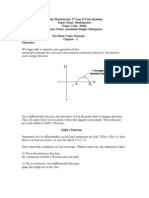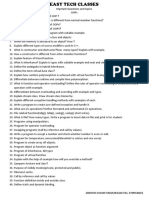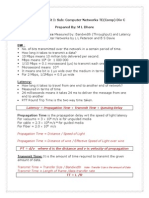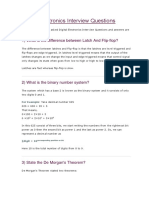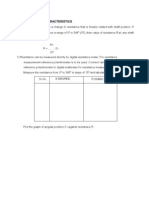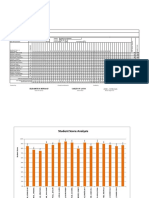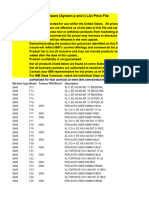Numerical Methods Viva
Numerical Methods Viva
Uploaded by
hksaifeeCopyright:
Available Formats
Numerical Methods Viva
Numerical Methods Viva
Uploaded by
hksaifeeCopyright
Available Formats
Share this document
Did you find this document useful?
Is this content inappropriate?
Copyright:
Available Formats
Numerical Methods Viva
Numerical Methods Viva
Uploaded by
hksaifeeCopyright:
Available Formats
Numerical methods viva voce questions Experiment no.
. 1: C program for finding smallest positive root of an equation by Bisection method
1) What do you mean by root of an equation? 2) In bisection method every time we reduce the interval by half? 3) What is intermediate value theorem? 4) Does bisection method give guarantee of convergence? 5) As compared to other iteration methods, does bisection method takes more number of iterations? 6) Do we apply intermediate value theorem repeatedly in bisection method? 7) What is the graphical meaning of Bisection method? 8) Explain bisection method? 9) What is the use of function fabs in C? 10) What is the use of function sqrt in C? 11) Name some commonly used mathematical functions in C? 12) Name some commonly used header files in C? 13) What is the syntax of for loop in C? 14) What is the syntax of if loop in C? 15) What are the different methods of finding root of an equation? 16) What is the difference between library functions and user defined functions in C? 17) What is the formula for finding the root by using the bisection method? 18) What is the formula of iteration by bisection method? 19) What are the variables a and b in bisection method program? 20) What is aerr in bisection method program? 21) What is maxitr in bisection method program?
Experiment no. 2: C program for finding smallest positive root of an equation by Newton-Raphson method 1) Does Newton-Raphson method give guarantee of convergence? 2) What is the use of function fabs in C? 3) As compared to other iteration methods, does Newton-Raphson method takes less number of iterations? 4) What is the graphical meaning of Newton-Raphson method? 5) The process of finding the roots of equation is called? 6) Which are the different equations whose solution/roots we can directly find out? 7) What is iterative method of finding the root of an equation? 8) What do you mean by bracketing method? 9) Which are the different bracketing methods? 10) The root lies in between which two points? 11) Explain Newton-Raphson method? 12) Whether the Newton-Raphson method is bracketing method or open end method? 13) What do you mean by transcendental equations? 14) What is the difference between linear and non linear equation? 15) What is the formula of iteration by newton-raphson method? 16) What do mean by call by value with reference to functions? 17) What do you mean by iteration? 18) A program in C always starts with ___________function? 19) What are the different types of variables in C? 20) What do you mean by syntax error in C? 21) What do you mean by logical error in C? 22) What is the graphical meaning of successive approximation method? 23) What is aerr in Newton-Raphson method program? 24) What is maxitr in Newton-Raphson method program?
Experiment no. 3: C program for finding smallest positive root of an equation by false position method 1) Does false position method guarantee of convergence? 2) What is the use of function fabs in C? 3) What is the difference between false position method and secant method? 4) Which are the equations whose roots we cannot directly find out? 5) Whether the false position method is bracketing method or open end method? 6) The false position method is also called as? 7) The degree of every algebraic equation which denotes? 8) What is the formula for finding the root of the equation by using the false position method? 9) Explain false position method? 10) What is the formula of iteration by secant method? 11) What is the formula of iteration by false-position method? 12) What is the formula of iteration by successive approximation method? 13) What is stopping criteria for finding root of an algebraic equation? 14) In successive approximation method which condition should be satisfied by (x) to be valid? 15) Successive approximation method is also known as? 16) What is aerr in false position method program? 17) What is maxitr in false position method program?
Experiment no. 4: C program for Simultaneous linear algebraic equations by Gauss Elimination method 1) What do you mean by augmented matrix? 2) Apart from gauss elimination methods what are other methods to find solution of simultaneous linear equations? 3) How we find out co-factor of an element? 4) What do you mean by upper triangular matrix? 5) What do you mean by square matrix? 6) What is the syntax of for loop in C? 7) What are the advantages of studying numerical methods? 8) What is floating point representation of numbers? 9) What is normalization of numbers? 10) What do you mean by significant digits? 11) What do you mean by back substitution in gauss elimination method? 12) What is the difference between Gauss-Jacobi and gauss-Siedel method? 13) Of the two methods Jacobi and Gauss-Siedel which one requires more iteration to converge? 14) What is matrix inversion method for solving simultaneous algebraic equations? 15) What is characteristic equation? 16) Can an Eigen value have multiple Eigen vectors? 17) What do you mean by normalized Eigen vector? 18) Is Gauss-Siedel a direct type method? 19) Is Gauss-Jacobi an iterative method? 20) Matrix inversion method is direct method? True or false? 21) Gauss-elimination method is an iterative method? True or false?
Experiment no. 5: C program for finding value of y corresponding to value of x by Newtons Forward Interpolation method 1) What is the syntax of for loop in C? 2) Which Newtons interpolation formula is used to find out value of function near the beginning or before the tabulated values? 3) Which Newtons interpolation formula is used to find out value of function near the end or ahead of the tabulated values? 4) Can Newtons forward interpolation formula be used for data points with unequal intervals? 5) Can Newtons backward interpolation formula be used for data points with unequal intervals? 6) Name some techniques other than Newtons forward interpolation for interpolating a polynomial? 7) What is the difference between forward differences and backward differences? 8) Is the value of forward and backward differences unequal? 9) What do mean by step size h? 10) What is p in Newton Forward interpolation formula? 11) What is y0 in Newton Forward interpolation formula? 12) What is 2y0 in Newton Forward interpolation formula? 13) What is p in Newton Backward interpolation formula? 14) What is yn in Newton Backward interpolation formula? 15) What is 2yn in Newton Backward interpolation formula? 16) What do you mean by slope at any point on the curve? 17) What do you mean by interpolating polynomial? 18) What is Taylor series? 19) What do you mean by first order difference in interpolation with equal intervals? 20) What do mean by second order difference in interpolation with equal intervals? 21) If the number of data pairs in case of interpolation is n then which order differences are going to be zero? 22) Why we have used 2-D array for saving differences in Newton forward interpolation?
Experiment no. 6: C program for finding value of y corresponding to value of x by Lagranges Interpolation method 1) 2) 3) 4) What do you mean by unequal intervals? What do mean by entry? What do you mean by arguments? Which technique other than Lagranges interpolation is used for interpolation of data points with unequal intervals? 5) What is the syntax of for loop in C? 6) What is inverse lagranges interpolation? 7) Objects are ___________of classes? 8) Classes are ____________for objects? 9) What is procedure oriented programming? 10) What are drawbacks of procedure oriented programming? 11) Does data flow freely in object oriented program? 12) What do you mean by reusability with reference to OOP? 13) What do you mean by extensibility with reference to OOP? 14) Name few main characteristic of procedure oriented programming? 15) What is Lagranges inverse interpolation formula? 16) What is 2-D array in C programming? 17) What is the difference between Lagranges interpolation and Lagranges inverse interpolation? 18) Does interpolating polynomial exactly fits the given data? 19) What is the difference between interpolation and approximations? 20) What do you mean by divided difference in interpolation with unequal intervals?
Experiment no. 7: C program for finding value of integral of a function by trapezoidal rule 1) What is the syntax of for loop in C? 2) From which basic formula we derive trapezoidal rule? 3) The format specifier for integer type variable is? 4) The format specifier for float type variable is? 5) What are different operators used in C? 6) What do you mean by precision? 7) Can a decimal number be exactly represented in binary form? 8) What do you mean by data errors? 9) What do you mean by conversion errors? 10) What do you mean by numerical errors? 11) What do you mean by round off errors? 12) What do you mean by truncation errors? 13) What is n in numerical integration? 14) What is formula of trapezoidal rule for finding integral of a given function? 15) What do you mean by data encapsulation? 16) What do you mean by data abstraction? 17) What is base class? 18) What is derived class? 19) What is the formula for k1 in RK-4 method? 20) What is the formula for k2 in RK-4 method?
Experiment no. 8: C program for finding value of integral of a function by Simpsons 1/3rd rule 1) What is y0 in Simpsons formula? 2) What is yn in Simpsons formula? 3) What is h in Simpsons formula? 4) What are the methods other Simpsons 1/3rd rule for numerical integration? 5) In Simpsons 1/3rd rule the number of intervals should always be an __________ number? 6) Simpsons 1/3rd rule gives better result than trapezoidal rule? True or false? 7) Simpsons 1/3rd rule gives better result than Simpsons 3/8th rule? 8) Which method can be further applied to improve the accuracy of Simpsons 1/3 rd rule? 9) What is the syntax of for loop in C? 10) What is formula of Simpsons 1/3rd rule for finding integral of a given function? 11) What is n in numerical integration? 12) What is the formula for k3 in RK-4 method? 13) What is the formula for k4 in RK-4 method? 14) What is the use of clrscr() function? 15) What is the use of getch() function?
Experiment no. 9: C program for finding value of integral of a function by Simpsons 3/8th rule 1) What is the syntax of for loop in C? 2) What are different types of errors? 3) What do you mean by inherent errors? 4) What do you mean by accuracy? 5) What is formula of Simpsons 3/8th rule for finding integral of a given function? 6) What is n in numerical integration? 7) In Simpsons 1/3rd rule the number of intervals should always be an __________ number? 8) Simpsons 1/3rd rule gives better result than trapezoidal rule? True or false? 9) Simpsons 1/3rd rule gives better result than Simpsons 3/8th rule? 10) What is Taylor series method to solve ordinary differential equation? 11) What is y0 in Simpsons 3/8th formula? 12) What is yn in Simpsons 3/8th formula? 13) What is the graphical meaning of Eulers method? 14) What is the graphical meaning of modified Eulers method? 15) What is the formula for y in Runge-Kutta fourth order method? 16) Runge-Kutta second order method is nothing but _______________modified Eulers method? 17) What do you mean by dynamic binding in OOP? 18) What is the syntax of while loop in C? 19) What is the syntax of do-while loop in C? 20) What is the use of return function? 21) Every statement in C language should end with a ____________?
Experiment no. 10: C program for finding value of integral of a function having limit from -1 to 1 by 2 point and 3 point Gauss quadrature formula 1) 2) 3) 4) What are two types of gauss quadrature formula? What does the function sqrt do? What is the syntax of for loop in C? What is the of 3-point gauss quadrature formula for finding integral of a given function whose limits is from -1 to 1? 5) What is the of 2-point gauss quadrature formula for finding integral of a given function whose limits is from -1 to 1? 6) In solving problem for integration by gauss quadrature formula, if the limit is not from -1 to 1 then how we convert the limits? 7) What is the difference between 2 point and 3 point gauss quadrature formula? 8) How we solve simultaneous differential equation by RK-4 method? 9) How we solve second order differential equation by RK-4 method? 10) In finite difference method we replace y by what equation? 11) In finite difference method we replace y by what equation? 12) What do you mean by objects in OOP? 13) What do you mean by classes in OOP? 14) What is inheritance in OOP? 15) What is polymorphism in OOP? 16) What do you mean by message passing in OOP? 17) Name few applications of OOP? 18) Classes are user-defined data types? True or false? 19) What is the variable s in program? 20) What is the variable s1 in program? 21) What is the variable s2 in program?
You might also like
- Ford Everest Service ManualDocument3 pagesFord Everest Service Manualbiang_kerok150% (8)
- BARC Previous Year Question Paper 2 For ECEDocument3 pagesBARC Previous Year Question Paper 2 For ECEsai kumar vemparala100% (1)
- Viva Questions For BEE (MU) PDFDocument46 pagesViva Questions For BEE (MU) PDFAbhishek Chaudhary78% (9)
- INFOSYS (SP&DSP) Placement Material by PLACEMENT LELODocument27 pagesINFOSYS (SP&DSP) Placement Material by PLACEMENT LELODigvijay SinghNo ratings yet
- PPS Important QuestionsDocument2 pagesPPS Important Questionspradeep100% (5)
- Microwave Engineering Lab Viva 1Document10 pagesMicrowave Engineering Lab Viva 1Armando CajahuaringaNo ratings yet
- Short Questions Numerical Methods July-21Document6 pagesShort Questions Numerical Methods July-21সৌভিক মাজি100% (1)
- CP Viva Questions With AnswersDocument18 pagesCP Viva Questions With AnswersPawanAgarwalNo ratings yet
- Plot Characteristics of FETDocument4 pagesPlot Characteristics of FETTapobroto Chatterjee100% (3)
- CP Viva QuestionsDocument10 pagesCP Viva Questionskvsrvzm67% (3)
- Engineering Chemistry Viva QuestionsDocument3 pagesEngineering Chemistry Viva Questionspmosae38% (8)
- ECS Lab (Network Theory) Viva Voce Questions With AnswersDocument22 pagesECS Lab (Network Theory) Viva Voce Questions With AnswersSatish Bojjawar40% (5)
- Electronics Workshop VivaDocument14 pagesElectronics Workshop VivaUsha ShanmugamNo ratings yet
- 60 Objective Type Questions On Vlsi DesignDocument12 pages60 Objective Type Questions On Vlsi Designpawan0% (1)
- Rules For Solving Numerical Problems On Lime Soda ProcessDocument3 pagesRules For Solving Numerical Problems On Lime Soda ProcessAyushman Singh ChandelNo ratings yet
- C Viva QuestionsDocument9 pagesC Viva QuestionsLakshmi Lakshminarayana83% (6)
- SASken - QuesDocument33 pagesSASken - QuesMaheshNo ratings yet
- Btech 1st Sem: Maths: Mean Value TheoremDocument7 pagesBtech 1st Sem: Maths: Mean Value TheoremTechno India Group86% (7)
- Vtcmos & MtcmosDocument13 pagesVtcmos & MtcmosBunny harsha100% (1)
- C++ VIVA Question and Answers by Mcacareers - inDocument45 pagesC++ VIVA Question and Answers by Mcacareers - inVishal Gupta100% (1)
- Programming in C VivaDocument14 pagesProgramming in C VivaMarieFernandes100% (1)
- C Viva QuestionsDocument4 pagesC Viva QuestionsPREETAM SOW MONDAL63% (8)
- CPDS Viva QuestionsDocument20 pagesCPDS Viva QuestionsUday Desiraj67% (6)
- VLSI Lab Viva Questions and Answers 1Document21 pagesVLSI Lab Viva Questions and Answers 1anand_duraiswamy0% (1)
- IV-cse DM Viva QuestionsDocument10 pagesIV-cse DM Viva QuestionsImtiyaz AliNo ratings yet
- VIVA Question-RectifierDocument3 pagesVIVA Question-RectifierMaheswariRV100% (1)
- Microprocessor Lab Viva Questions & AnswersDocument11 pagesMicroprocessor Lab Viva Questions & AnswersOishika C.100% (2)
- C Debugging QuestionsDocument5 pagesC Debugging QuestionsRajesh VenkatachalamNo ratings yet
- D - Jayakumar Ece Ece Ece Viva Questions-JkDocument20 pagesD - Jayakumar Ece Ece Ece Viva Questions-Jktinku990056% (9)
- Microwave & Optical Engineering Question BankDocument47 pagesMicrowave & Optical Engineering Question BankThiagu RajivNo ratings yet
- AssignmentsDocument5 pagesAssignments20EEE24 Balaji kanna M100% (3)
- Viva QuestionsDocument7 pagesViva QuestionsAshmika P100% (1)
- TOC - MCQ Unit 1 To 3Document19 pagesTOC - MCQ Unit 1 To 3priyanka mallawatNo ratings yet
- Algebraic Laws For Regular EpxressionsDocument14 pagesAlgebraic Laws For Regular Epxressionsa_d7770% (3)
- DAC ADC Interfacing With 8051Document37 pagesDAC ADC Interfacing With 8051Gowri100% (1)
- Important Questions in C++Document1 pageImportant Questions in C++abhishek singh0% (1)
- Bca s101 MathDocument11 pagesBca s101 Mathanilperfect0% (1)
- Basic Electronics Lab Viva VoceDocument16 pagesBasic Electronics Lab Viva Voceapi-262852837100% (2)
- Viva QuestionsDocument12 pagesViva QuestionsJayesh Tanwani50% (4)
- MPMC 2marks (Unit 1 To 5) (Q & A)Document32 pagesMPMC 2marks (Unit 1 To 5) (Q & A)Ganapathy Ramadoss100% (2)
- Unit V Finite Word Length Effects in Digital FiltersDocument3 pagesUnit V Finite Word Length Effects in Digital Filterstamizhanps67% (3)
- Interview Questions-Data PatternsDocument2 pagesInterview Questions-Data Patternssarav dNo ratings yet
- Digital Electronics Lab Viva QuestionsDocument2 pagesDigital Electronics Lab Viva Questionspramodrp200750% (8)
- Linear Integrated Circuits Lab Viva VoceDocument8 pagesLinear Integrated Circuits Lab Viva Voceselvi0412100% (13)
- Viva Questions Defferentiator and IntegratorDocument2 pagesViva Questions Defferentiator and IntegratorMalik Hammad50% (2)
- Data Link NumericalsDocument22 pagesData Link NumericalsSuraj JorwekarNo ratings yet
- Viva Voce Questions On Communication SystemsDocument3 pagesViva Voce Questions On Communication SystemsZealWolf100% (3)
- Viva Question With AnswersDocument14 pagesViva Question With AnswersAsim AhmedNo ratings yet
- BEEM 2marks PDFDocument40 pagesBEEM 2marks PDFPragna Sidhireddy100% (1)
- Equivalence of Type ExpressionsDocument17 pagesEquivalence of Type ExpressionsVinayKumarSingh100% (1)
- M-1 Question Bank (Imp) : Unit-I MatricesDocument8 pagesM-1 Question Bank (Imp) : Unit-I MatricesSunny Vardhan100% (1)
- Digital Electronics Interview Questions: 1) What Is The Difference Between Latch and Flip-Flop?Document11 pagesDigital Electronics Interview Questions: 1) What Is The Difference Between Latch and Flip-Flop?yashuNo ratings yet
- Viva QuestionsDocument10 pagesViva QuestionsVijay Singh GourNo ratings yet
- Linear Integrated Circuits 70 Interview Questions and Solutions 2 - DivyumDocument14 pagesLinear Integrated Circuits 70 Interview Questions and Solutions 2 - Divyumbalu56kvNo ratings yet
- DSP Viva QueDocument6 pagesDSP Viva QueSp UdayNo ratings yet
- IM 3 Webercise-TanaraDocument1 pageIM 3 Webercise-TanaraLily TanaraNo ratings yet
- C and Data Structures Q and ADocument267 pagesC and Data Structures Q and AAnandaKrishna Sridhar100% (1)
- Crisil Interview QuestionsDocument7 pagesCrisil Interview QuestionsNagarajanRKNo ratings yet
- 6 VivaDocument5 pages6 VivaALVIN JOSENo ratings yet
- Question BankDocument4 pagesQuestion BankAanchal ChaudharyNo ratings yet
- FDS 2 Marks 50 QuestionsDocument2 pagesFDS 2 Marks 50 QuestionsdeviNo ratings yet
- Stepper Motor Control Using 8051Document7 pagesStepper Motor Control Using 8051hksaifee100% (1)
- Numerical Methods VivaDocument10 pagesNumerical Methods Vivahksaifee100% (5)
- SUBJECT: - Numerical Methods and Computer Programming. Max Marks:-80 Duration: - 3 HRSDocument2 pagesSUBJECT: - Numerical Methods and Computer Programming. Max Marks:-80 Duration: - 3 HRShksaifeeNo ratings yet
- DSP Question BankDocument5 pagesDSP Question BankhksaifeeNo ratings yet
- Viva Questions For Unity Gain AmplifierDocument1 pageViva Questions For Unity Gain AmplifierhksaifeeNo ratings yet
- NMCP Assignment Number 3 2012-2013Document1 pageNMCP Assignment Number 3 2012-2013hksaifeeNo ratings yet
- NMCP Test 2Document1 pageNMCP Test 2hksaifeeNo ratings yet
- Network Analysis Practical Viva-Voce QuestionsDocument44 pagesNetwork Analysis Practical Viva-Voce QuestionshksaifeeNo ratings yet
- Electrical Measurement and Instrumentation VivaDocument6 pagesElectrical Measurement and Instrumentation Vivahksaifee50% (2)
- Electrical Power Test Paper-IDocument3 pagesElectrical Power Test Paper-IhksaifeeNo ratings yet
- Potentiometer CharacteristicsDocument1 pagePotentiometer CharacteristicshksaifeeNo ratings yet
- Ee PracticalDocument92 pagesEe PracticalhksaifeeNo ratings yet
- Control QuestionsDocument6 pagesControl Questionshksaifee0% (1)
- Com Bi National Logic CircuitsDocument28 pagesCom Bi National Logic CircuitshksaifeeNo ratings yet
- TMP A9Document1 pageTMP A9hksaifeeNo ratings yet
- Teixeira ComplaintDocument11 pagesTeixeira ComplaintAbby PatkinNo ratings yet
- Manual API TestingDocument15 pagesManual API TestingKarinaNo ratings yet
- Shabarish Kesa h1b ResumeDocument3 pagesShabarish Kesa h1b Resumeapi-489910015No ratings yet
- ShareX Log 2022 05Document6 pagesShareX Log 2022 05Cristian Casanova RiveraNo ratings yet
- Bpro Service Manual English PDFDocument37 pagesBpro Service Manual English PDFPaulo CésarNo ratings yet
- Product Manager's ToolkitDocument30 pagesProduct Manager's Toolkitjavier100% (1)
- Intelimax+4G BrochureDocument2 pagesIntelimax+4G BrochureNghiêm Thành TúNo ratings yet
- Applet and StringDocument18 pagesApplet and StringxiliyeNo ratings yet
- Customer Engagement Benchmarks 2021 Southeast AsiaDocument46 pagesCustomer Engagement Benchmarks 2021 Southeast AsiaJessica Zivani WNo ratings yet
- Test Item Analysis: Elizabeth B. Beniasan Carlito F. LayosDocument5 pagesTest Item Analysis: Elizabeth B. Beniasan Carlito F. LayosLianne Kaye ApasaoNo ratings yet
- C APaxDocument4 pagesC APaxchickeyNo ratings yet
- Coyote Point Equalizer AdministrationDocument338 pagesCoyote Point Equalizer AdministrationmcgheezerNo ratings yet
- SSD vs HDD: Weaknesses, Data Recovery Factors And Failure RatesDocument7 pagesSSD vs HDD: Weaknesses, Data Recovery Factors And Failure Ratesthecybertech.inNo ratings yet
- SLED NASPO - IBM Power System Software ListDocument276 pagesSLED NASPO - IBM Power System Software ListJayson JHBZANo ratings yet
- Protocol CytometerDocument51 pagesProtocol CytometerzoraidaNo ratings yet
- Algorithm Design Paradigms: General Approaches To The Construction of Efficient Solutions ToDocument7 pagesAlgorithm Design Paradigms: General Approaches To The Construction of Efficient Solutions ToSanthini KaNo ratings yet
- IoT Based Water Level Indicator Using Ultrasonic SensorDocument11 pagesIoT Based Water Level Indicator Using Ultrasonic Sensorsri kanthNo ratings yet
- SIL765 Assignment 4Document3 pagesSIL765 Assignment 4Ankit KumarNo ratings yet
- DS Unit-3Document235 pagesDS Unit-3ADARSHA KUMAR 2021-CSEUGNo ratings yet
- Generic Printer Install: Go To Printer and Faxes and Select Add PrinterDocument8 pagesGeneric Printer Install: Go To Printer and Faxes and Select Add PrinterJavier SecadesNo ratings yet
- Installation Manual For Physical Planning z890Document122 pagesInstallation Manual For Physical Planning z890Rodolfo Becerra HernandezNo ratings yet
- Aug 22Document3 pagesAug 22Muhammed AydoğduNo ratings yet
- Fansadox Collection 347 Torrent Torrentz PDFDocument1 pageFansadox Collection 347 Torrent Torrentz PDFMichaelNo ratings yet
- 3705-03 - Getting - Started - With - OXSAS (2009)Document20 pages3705-03 - Getting - Started - With - OXSAS (2009)Santiago Jacobo100% (1)
- Covers Concepts Programs Authored by B.Kanna Babu: A Revolution in The Web Programming WorldDocument185 pagesCovers Concepts Programs Authored by B.Kanna Babu: A Revolution in The Web Programming WorldMAHENDER KUMARNo ratings yet
- MusaTaib ResumeDocument1 pageMusaTaib ResumeHassan.AnwarNo ratings yet
- Module 4 - Community Health Information Tracking System (CHITS)Document12 pagesModule 4 - Community Health Information Tracking System (CHITS)Zuriel San PedroNo ratings yet
- Thesis Proposal Brgy. Ramon MagsaysayDocument7 pagesThesis Proposal Brgy. Ramon MagsaysayfrivaldoaryanaNo ratings yet
- Advanced Customer Return Mgt1Document20 pagesAdvanced Customer Return Mgt1Ranjeet Ashokrao UlheNo ratings yet

















